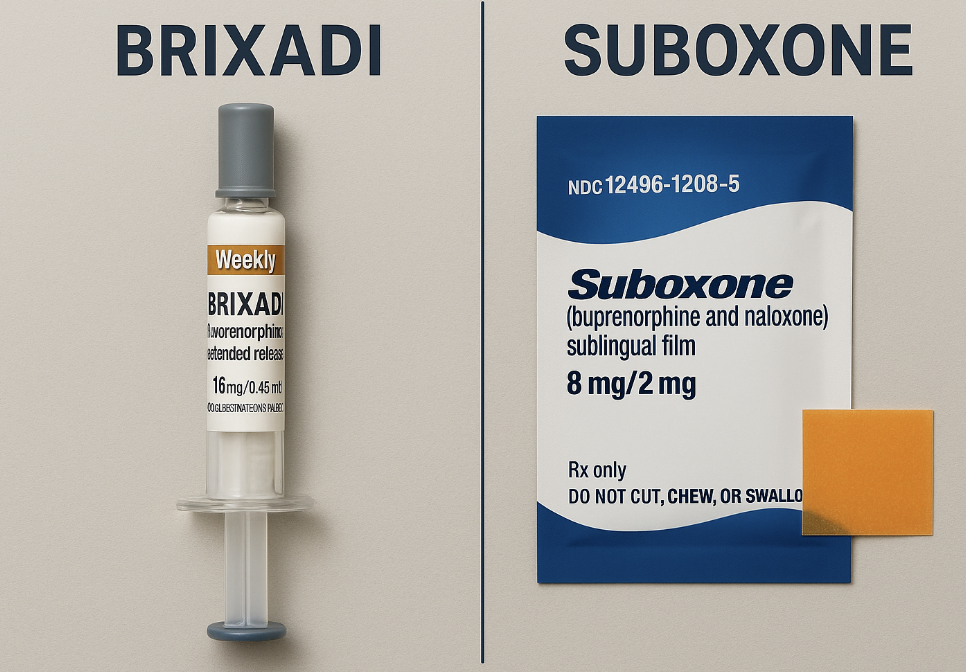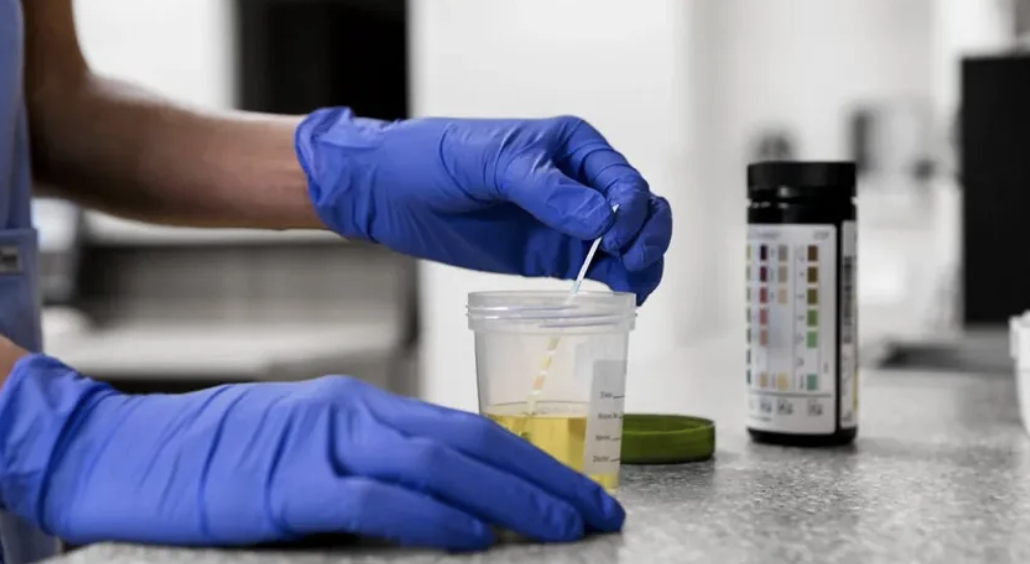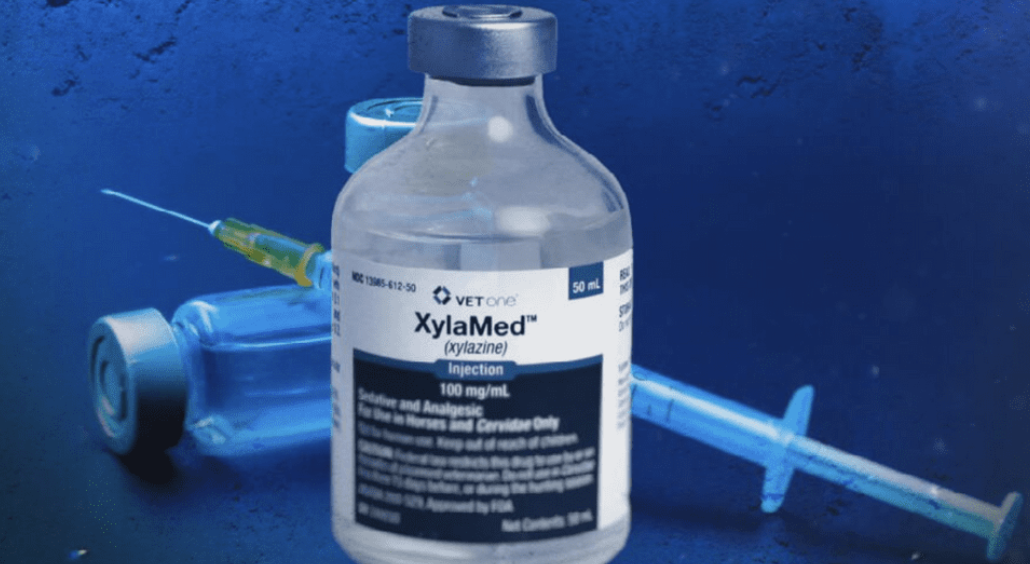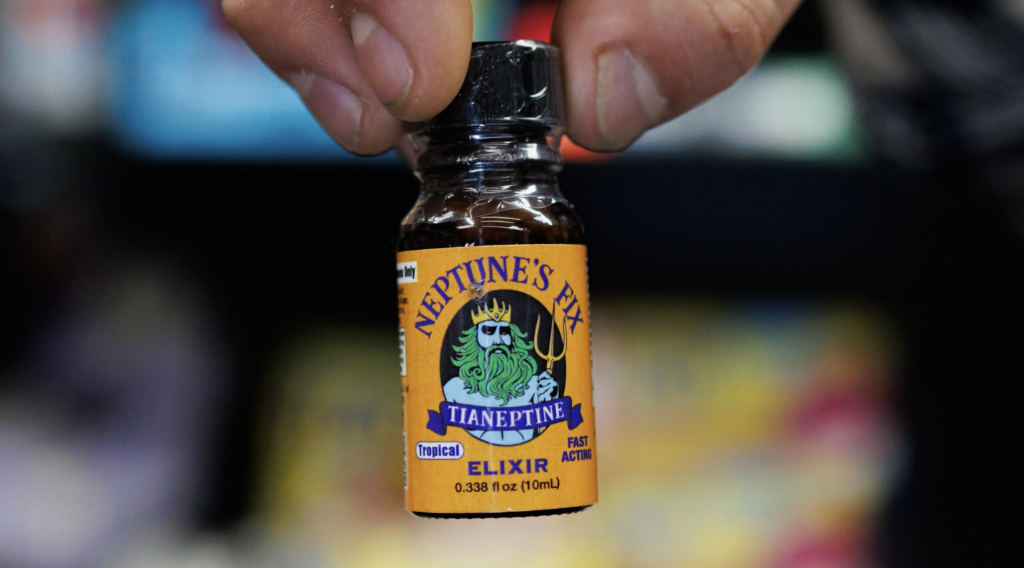Choosing between Brixadi and Suboxone for opioid use disorder? Both use buprenorphine but differ in administration and formulation. This article compares Brixadi vs Suboxone to help you find the best fit for your treatment needs.
Key Takeaways
- Brixadi is an injectable form of buprenorphine administered by healthcare providers, while Suboxone is an oral medication that combines buprenorphine and naloxone for enhanced misuse prevention.
- Brixadi’s extended-release formulation allows for less frequent dosing, making it ideal for patients struggling with daily adherence, whereas Suboxone offers flexibility through daily self-administration.
- Cost considerations reveal that Brixadi is significantly more expensive than Suboxone, which may influence treatment choices based on patient finances and insurance coverage.
What is Brixadi, and what is Suboxone?
When it comes to treating opioid use disorder, Brixadi and Suboxone are two of the most recognized and prescribed medications. Both are FDA-approved and contain buprenorphine, a partial opioid agonist that helps manage opioid cravings and withdrawal symptoms related to opioids. However, their formulations and methods of administration set them apart.
Brixadi is an injectable form of buprenorphine designed for extended-release, providing a steady therapeutic effect over time. Brixadi is administered by a healthcare provider, either weekly or monthly, which can significantly reduce the daily burden of drug medication management for patients. The buprenorphine injection can enhance treatment options for those in need.
On the other hand, Suboxone is an oral medication that combines buprenorphine with naloxone, an opioid antagonist that helps prevent misuse by inducing withdrawal symptoms if the medication is tampered with.
Both medications are effective in treating opioid use disorder, yet they cater to different patient needs and preferences. Brixadi’s extended-release formulation may be ideal for those who struggle with daily adherence, while Suboxone’s combination of buprenorphine and naloxone offers a robust deterrent against misuse. Additionally, these medications can help to treat opioid use disorder effectively.
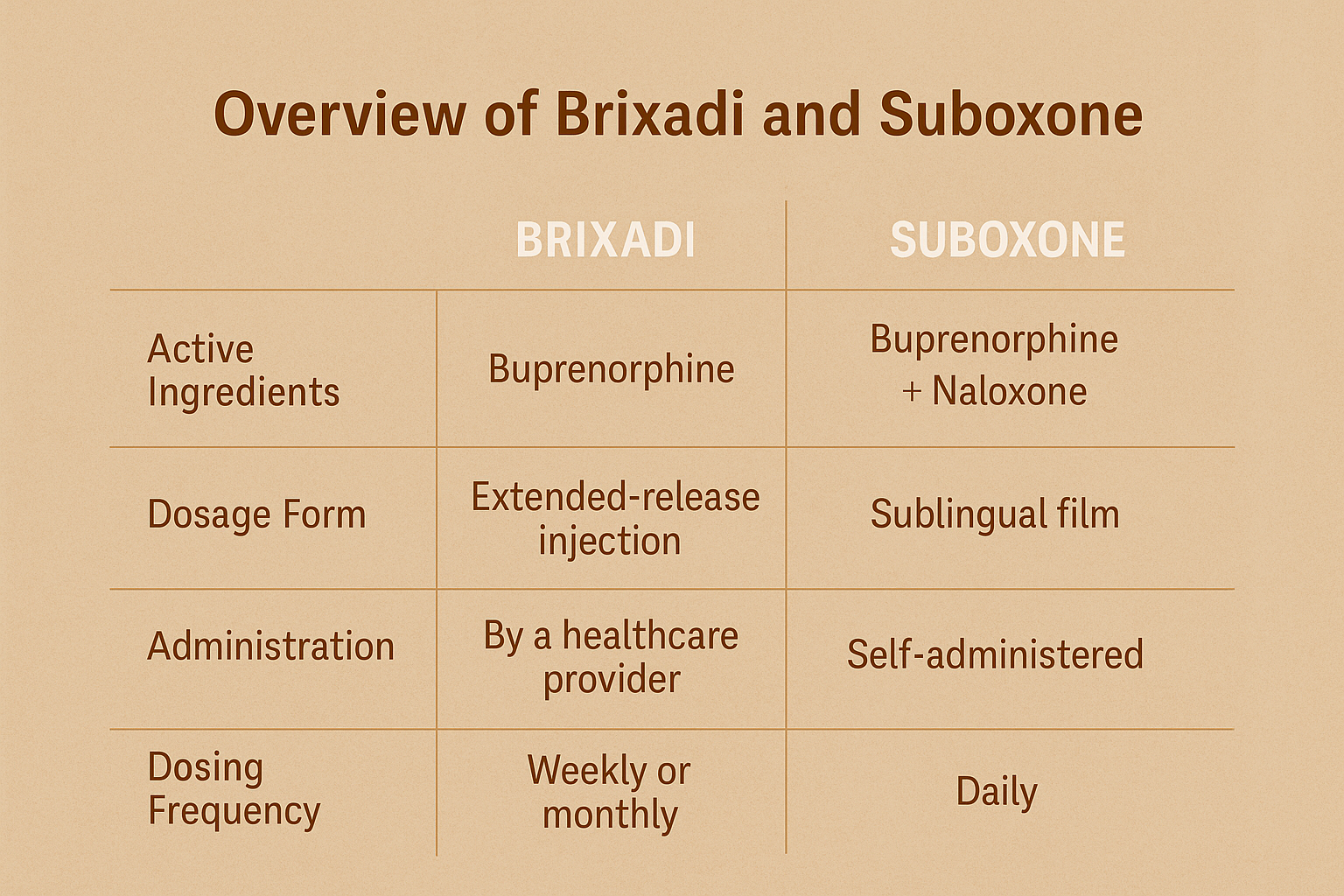
How does Brixadi differ from Suboxone?
The primary difference between Brixadi and Suboxone lies in their formulation and administration methods:
- Brixadi is a long-acting injectable, requiring less frequent dosing schedules—weekly or monthly.
- It is administered by a healthcare provider.
- This can be particularly beneficial for patients who find it challenging to adhere to a daily medication routine.
In contrast, Suboxone is taken daily as a sublingual film or tablet, which offers more flexibility but demands consistent daily compliance. This daily regimen can be advantageous for patients who prefer the autonomy of self-administration and the ability to make immediate dosage adjustments.
Here’s a side-by-side comparison to highlight the differences:
These differences significantly impact patient compliance, adherence, and supervision needs. While Brixadi minimizes the risk of misuse and ensures consistent medication levels, Suboxone offers greater flexibility and immediate dosage control.
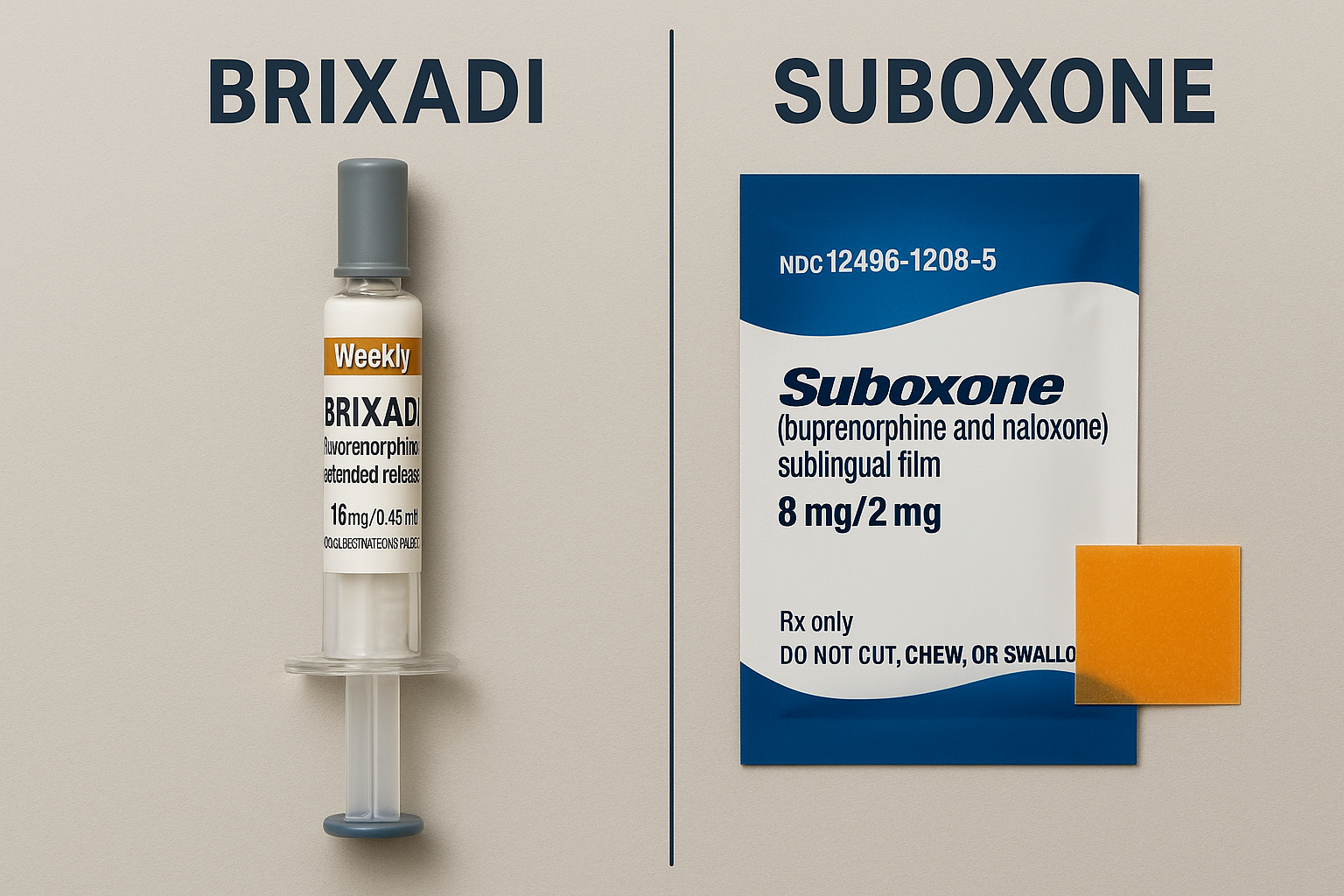
Active ingredients and formulations
The active ingredient in both Brixadi and Suboxone is buprenorphine, but the formulations differ significantly. Brixadi is an extended-release injectable form of buprenorphine, designed to provide:
- A steady release of the medication over time
- A sustained effect that helps manage cravings and withdrawal symptoms more consistently
- A reduction in the risk of relapse.
Suboxone is a combination medication. It contains both buprenorphine and naloxone. Naloxone is included to deter misuse by inducing withdrawal symptoms if the medication is tampered with or injected. This combination has proven effective in preventing abuse and ensuring that the medication is used as intended.
Brixadi’s formulation does not include naloxone, which impacts its safety profile. While this makes Brixadi less prone to causing withdrawal symptoms if misused, it also requires careful monitoring to prevent potential abuse. Understanding these differences is crucial for both patients and healthcare providers in selecting the most appropriate treatment option.
Administration methods and dosing schedules
Brixadi is administered as a monthly injection, either weekly or monthly, by a healthcare provider. This clinic-based administration ensures that the medication is given correctly and reduces the risk of misuse. For many patients, this less frequent dosing schedule can be a significant advantage, eliminating the daily burden of taking medication.
In contrast, Suboxone is taken daily as a sublingual film or tablet, which patients place under their tongue or on the inside of their cheek. This method offers more flexibility and allows for immediate dosage adjustments, which can be beneficial in managing symptoms and preventing relapse. However, it requires consistent daily adherence, which can be challenging for some patients.
Effectiveness of Brixadi vs Suboxone
Clinical trials have shown both Brixadi and Suboxone to be effective in treating opioid use disorder, but user experiences vary. Brixadi has received an average user rating of 6.0, while Suboxone boasts a significantly higher average rating of 8.5, indicating greater overall satisfaction among users. This suggests that Suboxone may be more effective in managing opioid dependence for a broader range of patients.
Patient-reported outcomes also highlight differences in effectiveness. Suboxone users report a positive effect in 81% of reviews, suggesting it is more effective in reducing cravings and preventing relapse. In comparison, Brixadi users have noted withdrawal symptoms and insomnia as common side effects, which may impact its perceived effectiveness.
While both medications have moderate potential for substance abuse, Suboxone’s formulation with naloxone may enhance its effectiveness in preventing misuse. Public perception and clinical data suggest that Suboxone is generally more effective, but individual experiences can vary, and personal circumstances should guide the choice of treatment.
Side effects and safety profiles
Both Brixadi and Suboxone have side effects that patients need to be aware of. Common side effects of Brixadi include withdrawal symptoms, insomnia, and injection site reactions. In clinical trials, 4.7% of patients discontinued Brixadi due to adverse reactions, compared to 2.3% in the sublingual buprenorphine group.
Suboxone users report a broader range of side effects, including headache, constipation, and nausea. Serious risks associated with both medications include respiratory depression, particularly when combined with other central nervous system depressants. Both medications require careful monitoring to manage these risks effectively.
Withdrawal experiences can differ between the two medications. Brixadi users may experience withdrawal symptoms if the medication is misused, whereas Suboxone’s naloxone component helps mitigate this risk by inducing opioid withdrawal if tampered with. Understanding these safety profiles can help patients and healthcare providers manage withdrawal symptoms and make informed decisions about their treatment options.
Which medication is more convenient and accessible?
When it comes to convenience and accessibility, Brixadi and Suboxone offer different advantages:
- Brixadi’s extended-release formulation allows for weekly or monthly injections.
- This reduces the daily burden of medication management.
- It can be especially beneficial for patients who struggle with daily adherence or have busy lifestyles.
Suboxone, available as a daily sublingual film or tablet, provides immediate doses adjustments and greater flexibility. However, it requires consistent daily intake, which can be a challenge for some patients, especially when taken orally.
Brixadi’s administration by healthcare professionals minimizes the risk of misuse and ensures proper dosing, while Suboxone’s availability in pharmacies makes it more accessible for those who prefer self-administration.
Cost comparison: Brixadi vs Suboxone
The cost of treatment is a significant consideration for many patients. Brixadi is priced at approximately $2,911.44 for a 0.16 mL dose, which is substantially higher than Suboxone, which costs around $170.45 for a 30-film pack at the 2 mg-0.5 mg strength. Suboxone’s lower cost per unit makes it a more economical option for many patients.
Additionally, Suboxone offers lower-cost generic options, whereas Brixadi, being a newer medication, does not have a generic alternative. Insurance coverage and patient assistance programs can further influence out-of-pocket costs, with Medicaid and Medicare coverage varying by state. Patients should consult with their healthcare providers and insurance companies to understand their specific coverage and financial assistance options.
Who is a better candidate for Brixadi or Suboxone?
The choice between Brixadi and Suboxone often depends on individual patient needs and circumstances. Brixadi may be better suited for patients who struggle with daily adherence or are at risk of diversion, as its extended-release formulation reduces the need for daily dosing. It is also an excellent option for those who prefer a less frequent dosing schedule.
Suboxone may also be explored in specific off-label contexts, such as suboxone for alcohol use disorder, although this application requires careful clinical oversight.Factors to consider when determining the best treatment option include:
- Age
- Lifestyle
- Co-occurring conditions
- Pregnancy
- Prior misuse
What do medical guidelines and professionals recommend?
Medical guidelines from organizations such as SAMHSA, ASAM, and the CDC recommend:
- Monitoring patients for signs of opioid dependence and addiction while prescribing Brixadi.
- Ensuring patients using Brixadi have access to naloxone for emergency opioid overdose treatment.
- Educating patients on the use of naloxone.
Brixadi is recommended as part of a comprehensive treatment plan that includes counseling and support for opioid use disorder. Clinicians are advised to coordinate care among healthcare providers when patients are prescribed benzodiazepines alongside Brixadi to mitigate risks.
These guidelines emphasize the importance of a holistic approach to health treatments, incorporating both medication and medication-assisted treatment therapy.
Are there alternatives to Brixadi and Suboxone?
Several alternatives to Brixadi and Suboxone are available for treating opioid use disorder. Sublocade vs suboxone is another comparison worth exploring, as Sublocade is also a monthly injectable form of buprenorphine that some patients may prefer. Methadone, another long-standing treatment option, is effective but requires daily clinic visits. Buprenorphine treatment is also an important consideration for many patients.
Vivitrol, a long-acting injectable form of naltrexone, is another alternative that works as an opioid antagonist. Each of these alternatives has its pros and cons, and the choice of treatment should be based on individual patient needs and preferences. Consulting with addiction specialists can help determine the most appropriate option.
Bottom Line Which is better, Brixadi or Suboxone?
Choosing between Brixadi and Suboxone depends on various factors, including:
- Delivery method
- Cost
- Compliance needs
- Abuse potential
While Suboxone generally has higher user satisfaction ratings and offers a combination of buprenorphine and naloxone for added misuse deterrence, Brixadi’s extended-release injectable form can be more convenient for those who struggle with daily medication adherence.
Ultimately, the best choice is highly individual and should be made in consultation with a certified addiction treatment provider. A personalized treatment plan that considers personal circumstances, treatment goals, and medical history is crucial for effective addiction recovery from opioid addiction to treat opioid dependence.
FAQs about Brixadi vs Suboxone
What are the main differences between Brixadi and Suboxone?
Brixadi is an injectable, long-acting form of buprenorphine given weekly or monthly, while Suboxone is an oral daily medication that combines buprenorphine with naloxone to deter misuse. Thus, the primary difference lies in the method of administration and formulation designed for specific treatment approaches.
Are there any cost differences between Brixadi and Suboxone?
There are notable cost differences between Brixadi and Suboxone, with Brixadi being approximately $2,911.44 for a 0.16 mL dose compared to around $170.45 for a 30-film pack of Suboxone. Additionally, Suboxone has generic versions available, which can further reduce expenses.
Which medication is more convenient for patients?
Brixadi's extended-release formulation is generally more convenient for patients as it minimizes the need for daily medication, making it less burdensome. In contrast, Suboxone, while allowing for daily self-administration, requires strict adherence to a routine.
What are the common side effects of Brixadi and Suboxone?
Both Brixadi and Suboxone can cause common side effects, including withdrawal symptoms and insomnia for Brixadi, and headache, constipation, and nausea for Suboxone. Additionally, both medications carry serious risks, such as respiratory depression.
Who should consider taking Brixadi over Suboxone?
Individuals who have difficulty with daily medication adherence, are at risk of medication diversion, or prefer less frequent dosing should consider taking Brixadi over Suboxone. In contrast, Suboxone may be more suitable for those needing flexible dosing and self-administration.


